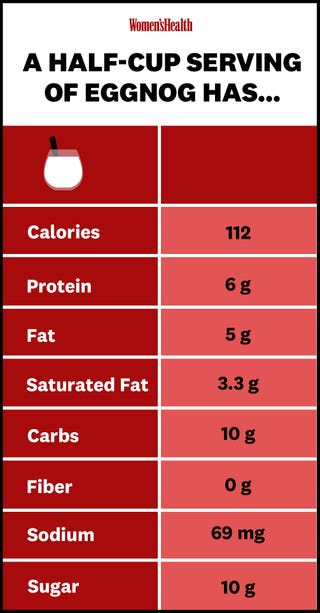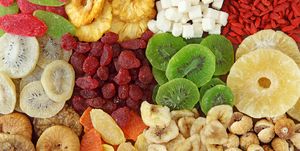

Certain things just feel right during the holidays: watching Home Alone (multiple times, of course), shopping online (excessively), and drinking eggnog (lots of it).
But yeah, is eggnog healthy? It does have “egg” in its name…but that might just be wishful thinking.
There’s a pretty good reason why eggnog tastes so good.
Your typical batch of eggnog is made with heavy cream, whole milk, sugar, raw eggs (yolks and sometimes the whites too), nutmeg, and some form of booze—usually rum, brandy, or Cognac.
Wait, raw eggs, you say? How is that safe!? Raw eggs give ‘nog that trademark creamy texture, but obviously, they do pose a salmonella risk.
But before you toss out your carton, know that the risk of getting salmonella from an egg is REALLY low (like, one in 20,000). Still, if you are pregnant or have a compromised immune system, you might not want to risk food poisoning for the sake of a beverage. You can buy pasteurized eggs and use those instead (they’ve been treated to kill off bacteria), or “pre-cook” your egg mixture to 160 degrees to ensure that your drink has zero risk of salmonella, per FoodSafety.gov.
What does eggnog’s nutrition look like though?
Sorry, but eggnog isn’t exactly a health drink. “Eggnog is high in calories and saturated fat because of the whole milk and heavy cream. It’s also loaded with sugar,” says Christy Brissette, R.D., President of 80 Twenty Nutrition.

Amanda Becker
Of course, toss in a shot of rum (because, duh) and you’re adding another 64 calories for a total of about 176 calories per serving.
Are you ever actually measuring out that half-cup serving (or sticking with it) though? Yeah, neither am I. Brissette says most people drink at least a full cup—meaning you’re taking in more like 288 calories per spiked drink.
Here’s a silver lining: Because it’s made with milk, says Brissette, eggnog is rich in calcium, magnesium, phosphorus, and vitamins A and D.

And while the store-bought stuff is convenient (and sometimes has fewer calories and fat if it’s made with skim or low-fat milk), Brissette suggests making your own. That way you can use whole foods and avoid the artificial ingredients—high-fructose corn syrup, artificial flavors, and coloring—found in many pre-mixed eggnogs.
Okay…is eggnog any better (or worse) than spiked hot chocolate?
Depends. Hot chocolate can be higher or lower in calories than eggnog, depending on the recipe you’re using. Virgin, plain hot chocolate has 96 calories per half-cup serving…but that number can jump up to 250 to 300 calories if you add peppermint schnapps and decadent toppings like whipped cream or marshmallows.
But there are some nutritional perks as well. The pure cocoa in homemade hot chocolate contains flavanols, antioxidants that may help improve circulation and blood pressure.

And like eggnog, hot chocolate has some filling protein (four grams) and fat (three grams) from the milk. “If you’re drinking on an empty stomach, that can help you feel more satisfied and avoid a big sugar rush and subsequent crash,” says Brissette.
What about mulled wine? Is eggnog better than that?
Again, it depends on the recipe you’re using and what you’re adding to it. A five-ounce glass of red wine has 125 calories, no fat, and only four grams of carbs (much lower than what you get in eggnog)—but again, if your recipe calls for extra sugar, those numbers will def change.
The plus of mulled wine: It’s made with spices like cloves, cinnamon, and nutmeg, which also have antioxidants that may help boost your immune system during cold and flu season. “Whether these benefits balance out the booze is questionable,” Brissette says.
Whatever holiday bevvy you choose, Brissette also cautions that store-bought versions of all of these drinks are often loaded with added sugars. “Read your labels carefully and look for versions with little to no added sugar,” says Brissette. “You can always add more sweetness later if you really need it.”
How do you make healthy eggnog that doesn’t taste totally disgusting?
Brissette recommends DIY-ing it using skim milk or unsweetened almond milk. She also replaces the sugar in traditional recipes with monk fruit or stevia to cut back on calories and avoid added sugars. Or, try out this healthy eggnog recipe from Good Housekeeping, which uses low-fat milk instead of heavy cream to cut back on the saturated fat.
As for other variations:
The bottom line: Enjoy eggnog (in moderation), and be mindful of the stuff you add in your drinks—because it can really add up.
Source: Read Full Article